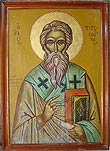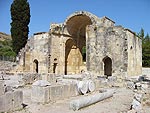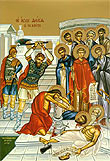| In
the beginning of the Roman Period the inhabitants were still worshipping
the ancient Greek gods, which the Romans had adopted and given Latin
names to, but in time some others were accepted, for instance the Asian
and Egyptian gods Cybele, Isis and Serapis.
|
| But
already in the middle of the first century A.D. Christianity began to
gain ground in Crete after Saint Paul's visit, when he entrusted the spreading
of the new religion on the island to his companion Titus . (See Paul's
Epistle to Titus, 1.5 ff.: "The
reason I left you in Crete was that you might straighten out what was
left unfinished and appoint elders in every town, as I directed you.").
|

|
| Paul
didn't have much confidence in the inhabitants of the island, as you can
read later on in the Epistle to Titus, 1, 10 ff.:
|
|
|
|
|
|
|
| "For
there are many rebellious people, mere talkers and deceivers, especially
those of the circumcision group. They
must be silenced, because they are ruining whole households by teaching
things they ought not to teach - and that for the sake of dishonest gain.
Even one of their own prophets has said, "Cretans are always liars,
evil brutes, lazy gluttons." This testimony is true. Therefore,
rebuke them sharply, so that they will be sound in the faith and will
pay no attention to Jewish myths or to the commands of those who reject
the truth. To the pure, all things are pure, but to those who are
corrupted and do not believe, nothing is pure. In fact, both their minds
and consciences are corrupted. They claim to know God, but by their
actions they deny him. They are detestable, disobedient and unfit for
doing anything good."
|
| Titus
became the first bishop in Crete and later on the patron saint of the
island. According to tradition - dating back to the 6th century - he
founded nine bishoprics on the island: Knossos, Ierapytna,
Kydonia, Cherronisos, Eleftherna, Lambi, Kissamos, Kandanos and Gortyna,
which became the metropolis. |

|
|
|
 |
Very
little information exists about the first years of Christianity in
Crete, only from the 3rd century does the information become more
extensive. At that
time the Roman emperor Decius initiated the first major persecution
of the Christians, whom he regarded as a threat to the empire. On 23rd
December 250, ten Christian martyrs were killed in the present-day village of Agii Deka,
a little east of Gortyna. According to Christian tradition the ten
martyrs came from different areas of Crete, but not from Eastern Crete.
Some people therefore wonder, whether Christianity had reached this
part of the island at that time. |
|
|
|
|
|
| Also
during the persecution of Maximianus and Diocletian in the year 304
many Christians were killed, for instance the bishop of Gortyna, Kyrillos,
the so-called 12 Cretan Soldier-Martyrs and the Holy Theofilos.
|
|
|
|
|
|